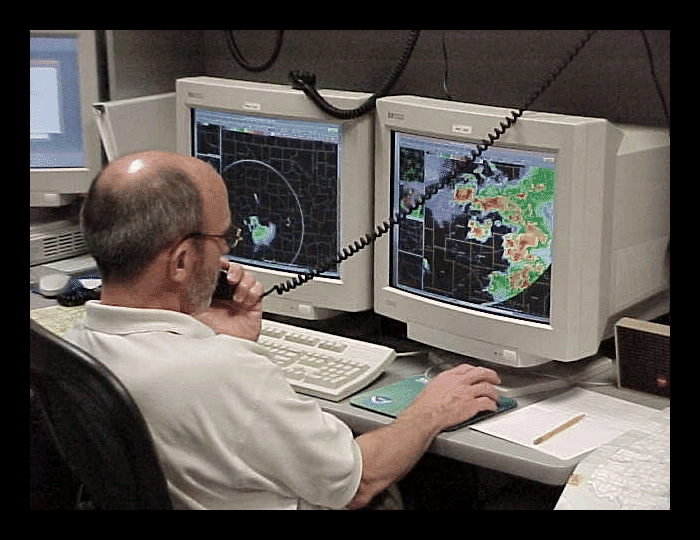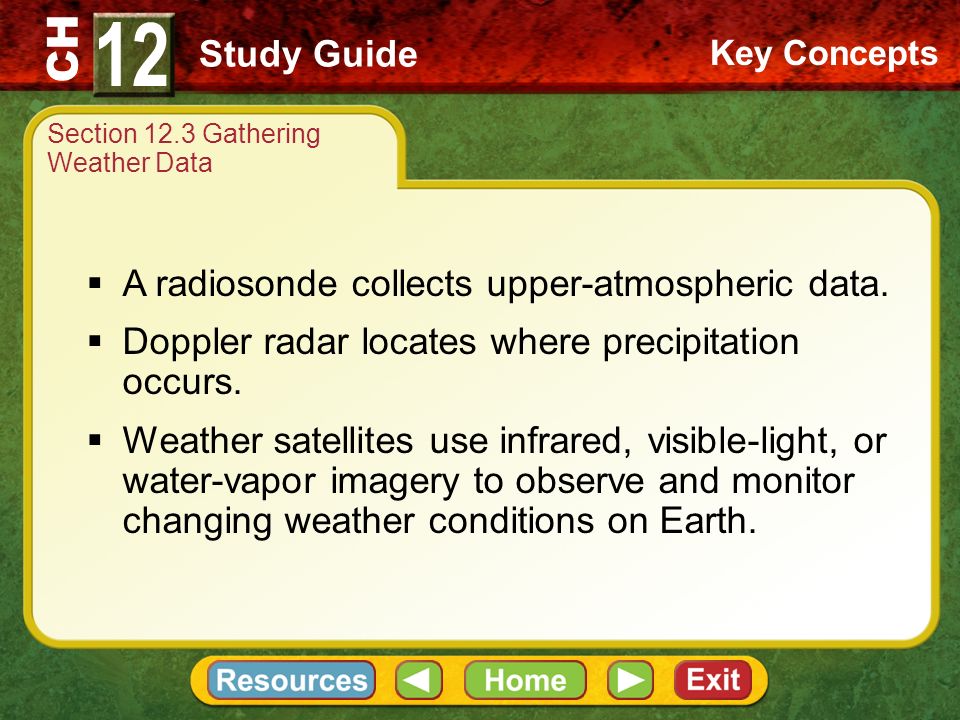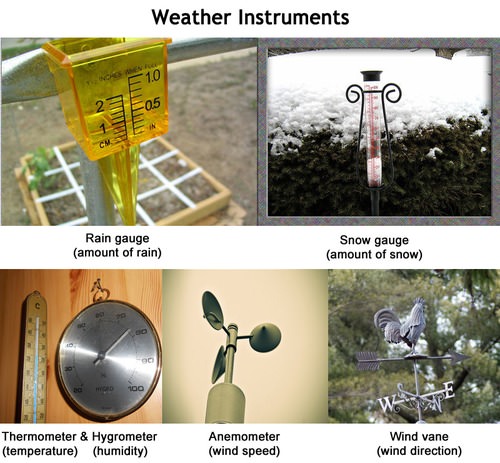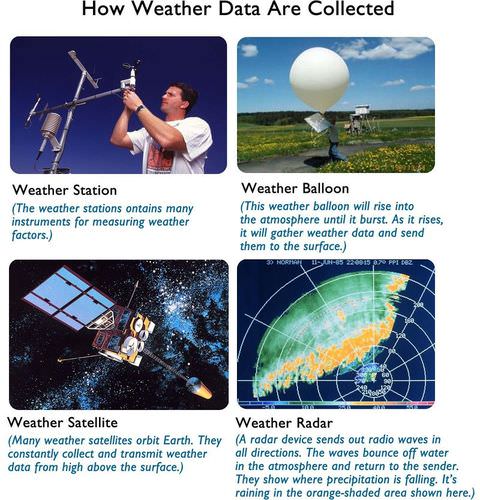Describe the Types of Weather Data Gathered by Satellites
When they focus on changes of the past 100-150 years they use observations made by modern scientific instruments. The ability to cover the entire planet frequently at low orbit allows polar.

Collecting Weather Data Ck 12 Foundation
Data gathered by weather satellites has been analyzed by scientists reporting that the Earths northern latitudes have become about ten percent greener since 1980 due to more vigorous plant growth associated with warmer temperatures and higher levels of atmospheric carbon dioxide.

. Specifically you should also be able to describe when it is appropriate to use visible satellite imagery and when it is not and discern the relative thickness of various cloud types. On these images clouds show up as white the ground is normally grey and water is dark. There are two types of weather satellites.
Weather satellites have been increasingly important sources of weather data since the first one was launched in 1952. Just like rooftop or mountain top views offer a wider view of your surroundings a weather satellites position several hundred to thousands of miles above Earths surface. 6 Weather satellites orbiting high above Earths surface take images of cloud patterns and storm systems and can track their movements.
Polar orbiting satellites orbit the Earth close to the surface taking six or seven detailed images a day. Polar-orbiting weather satellites orbit the Earth around the North and South Poles. List three technologies used to gather weather data.
Some of the data collected include air chemistry temperature precipitation cloud cover and wind speed. Data gathered by weather satellites has been analyzed by scientists. Geostationary satellites stay over the same location on Earth high above the surface taking images of the entire Earth as frequently as every 30 seconds.
The intensity of radiation emitted in all three of these bands or channels is. Instruments carried on balloons and wind profiling radar provide observations from the surface to more than 10 miles high. You often see such pictures on television weather broadcasts.
Weather balloons weather satellites and computer forecasts Describe the types of weather data gathered by satellites. Polar orbiting and geostationary. There are various subprocesses involved in the complete process of data science for weather prediction.
Weather models are at the heart and they are used both for forecasting and to recreate historical data. Weather satellites also record data about winds temperature rainfall water vapor wave height soil moisture and snow cover. This is the basis of satellite-based models.
Numerical Weather Prediction The most accurate weather forecasts are made by advanced computers with analysis and interpretation added by experienced meteorologists. Weather satellites are the best way to monitor large scale systems such as storms. Describe the types of weather data gathered by satellites.
After completing the sections on infrared imagery water vapor imagery and radar imagery you should also be able distinguish visible satellite imagery from these other types of images. The earths moon is an example of a natural satellite. Weather satellites are the result of human ingenuity.
Visible satellite pictures can only be viewed during the day since clouds reflect the light from the sun. Satellites can be polar orbiting or geostationary. And polar-orbiting satellites for longer-term forecasting.
The low orbit allows a satellite to cover every location on Earth and image the same area twice a day. Common types of these satellites include. Weather satellites are used to view and gather data about Earths weather and climate.
Polar Operational Environmental Satellites POES and Geostationary. NOAA operates three types of weather satellites. There are two main types of weather satellites defined by their orbital characteristics.
Satellite data having a global view complements land-based systems such as radiosondes weather radars and surface observing systems. Brightness radiance data from geosynchronous weather satellite images can be transformed into solar radiation fluxes at the surface. Roughly 80 percent of all data used to run computer forecast models comes from polar orbiting satellites alone so satellites are a critical part of weather forecast operations around the globe.
Satellites can measure atmospheric temperatures moisture and winds among other things. Satellites designed for weather data collection typically contain cameras and radar systems. However over the last decade machine learning has increasingly come to be applied in.
While primarily used to detect the development and movement of storm systems and other cloud patterns meteorological satellites can also detect other phenomena such as city lights fires effects of pollution auroras sand. Weather balloons are floating helium-filled balloons containing weather equipment. Although the mercury thermometer and.
For instance a stations daily average mean temperature is calculated by averaging the minimum and maximum temperatures for. A weather satellite is a type of satellite that is primarily used to monitor the weather and climate of the Earth. Predictive Modeling and Machine Learning.
From Raw Data to Finished Products. Visible infrared and infrared to terahertz. Images temperature humidity solar radiation wind speed and wind direction and images of clouds and storm systems.
How does the large amount of weather data gathered by various modern technologies affect the accuracy of weather forecasts. Climate researchers use every possible direct and indirect measurement to study the full history of Earths climate from the latest satellite observations to samples of prehistoric ice extracted from glaciers. There are three main types of satellite images available.
A satellite is an object that orbits a larger object such as a planet. Weather Satellites are an important observational tool for all scales of NWS forecasting operations. Satellites constantly capture information about glacier melting rates winds temperature and clouds.
NOAAs operational weather satellite system is composed of two types of satellites. Geostationary operational environmental satellites GOES for short-range forecasts warnings and observations. The most common processing steps used to turn daily weather data into climate data products involve straightforward mathematical operations such as averaging or adding measurements.
Satellites are able to record long-term changes such as the amount of ice cover over the Arctic Ocean in September each year. They get placed in a low orbit of around 850 km 530 miles above the planet. Data from satellites has truly revolutionized weather analysis and forecasting.
Meteorological satellites see clouds wildfires snow cover and ocean temperatures. Weather data is perhaps the most well known application of satellite technology. Landsat MODIS and the Tropical Rainfall Measuring Mission TRMM.
The types of energy weather satellites measure fall into three categories of the electromagnetic spectrum of light.

The Causes Of Weather Objectives Compare And Contrast

Objectives State The Importance Of Accurate Weather Data Ppt Video Online Download


0 Response to "Describe the Types of Weather Data Gathered by Satellites"
Post a Comment